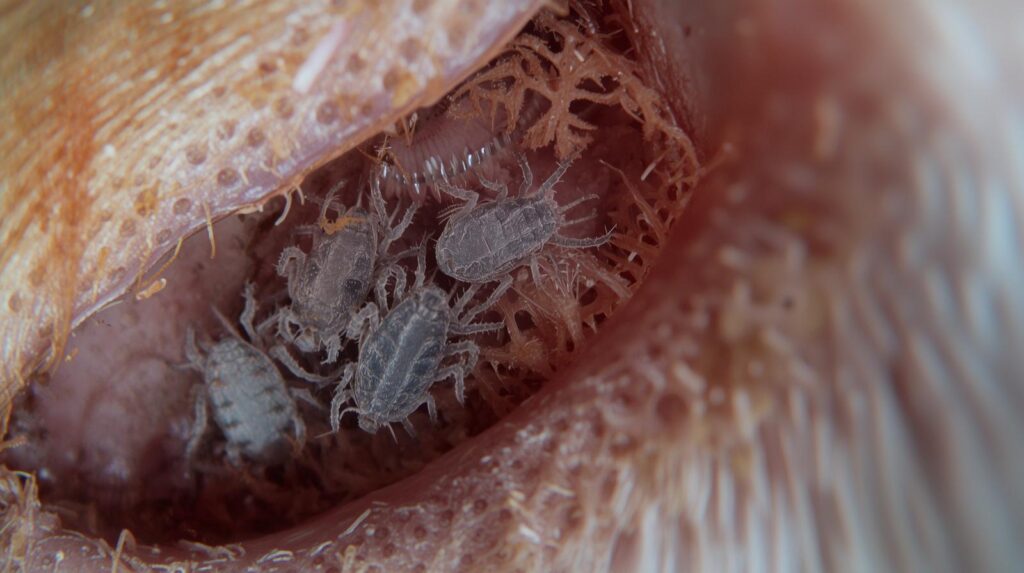Hey, has your dog been shaking their head like they’re trying to dislodge an invisible fly? My pup Max started doing that one summer, and it turned out to be ear mites in dogs. Those tiny bugs can make your buddy miserable fast. Ear mites in dogs are a common headache, but spotting them early and treating right can get things back to normal quick. Let’s walk through what they are, the signs to watch for, and how to knock them out.
Ear mites in dogs hit about 10% of pups yearly, especially younger ones or those around other animals. They’re not dangerous on their own, but they can lead to infections if ignored. I learned that the hard way with Max—his scratching turned into a sore ear. Good news? Treatment’s straightforward, and prevention’s even easier.
What Are Ear Mites in Dogs?
Ear mites are tiny parasites, smaller than a grain of salt, that love hanging out in your dog’s ear canal. They’re called Otodectes cynotis and feed on ear wax and oils. Think of them as uninvited guests crashing the party in your pup’s ears. They spread easy through contact with infected dogs, cats, or even bedding.
Max picked his up from a playdate at the dog park—turns out the other pup had them too. They’re super contagious, so if one dog in the house has ear mites in dogs, check everyone. The life cycle’s short: eggs hatch in days, and new mites pop out ready to multiply. That’s why quick action matters.

Common Symptoms of Ear Mites in Dogs
The biggest clue for ear mites in dogs? Constant head shaking or tilting, like your dog’s ear is buzzing. They’ll scratch at it like crazy, sometimes until it bleeds. Look for dark, crumbly discharge—coffee grounds mixed with wax. It smells bad too, like yeasty bread gone wrong.
Max had red, inflamed ears that swelled up from all the rubbing. Other signs include whining when you touch the ear or walking in circles. Puppies might seem extra restless. Tip: Shine a light in the ear—if you see tiny white specks moving, that’s them. But don’t poke around too much; you could push debris deeper.
In my opinion, these symptoms mimic yeast infections, so don’t guess. A quick vet peek saves confusion. If ignored, ear mites in dogs can cause hematomas—those painful blood blisters from shaking.
How Ear Mites Spread in Dogs
Ear mites in dogs jump from pet to pet via close contact, like snuggling or sharing toys. They’re tough too—can live off-host for weeks in the environment. Foxes and ferrets carry them, so outdoor dogs are at higher risk. Indoor pups aren’t safe if a visitor’s pet has them.
I isolated Max from our cat right away, but still treated her preventively. It’s like pink eye in kids—wash everything. Pro tip: Vacuum floors and wash bedding in hot water to break the cycle. FAQ: Can humans get ear mites in dogs? Nope, they’re species-specific, but wash your hands after handling.
Diagnosing Ear Mites in Dogs
Vets diagnose ear mites in dogs with a simple ear swab under a microscope. It’s quick—costs about $30—and shows the mites dancing around. They might check for secondary infections too, since mites irritate the skin.
With Max, the vet used an otoscope to look inside, then swabbed. No guesswork. If you’re rural, telehealth can start the process: Send a video of the ear, and they might spot the gunk. Warning: Home tests exist, but they’re iffy—stick to pros for accuracy.
Treatment Options for Ear Mites in Dogs
Treating ear mites in dogs starts with cleaning the ears. Vets recommend gentle cleansers like Epi-Otic—flush daily to remove debris so meds work better. Then, hit them with prescription drops or ointments containing insecticides. Stuff like selamectin (Revolution) kills mites in one dose.
Max got a spot-on treatment between his shoulders—easy peasy, no wrestling ears. Oral meds like Bravecto work too, especially if fleas are around. For pain, short-term steroids calm the itch. Most pups improve in 7–10 days. Real-life win: My neighbor’s dog was mite-free after two weeks, no more head shakes.

Over-the-counter options? They’re okay for mild cases but take longer—up to a month—and might not fully zap eggs. Always follow up with a vet recheck.
Home Remedies: Gentle Help for Ear Mites in Dogs
While waiting for the vet, some home tricks ease ear mites in dogs. Mix equal parts apple cider vinegar and water for a rinse—acidic enough to bug the mites but gentle. Or cooled green tea as a soothing soak. Apply with a cotton ball, but never use Q-tips deep in the ear.
I tried the vinegar mix on Max once—helped the smell, but didn’t cure it. Oil like mineral or olive can smother mites too, but it’s messy. Warning: Skip tea tree oil or hydrogen peroxide—they burn delicate skin. These are bridges, not full treatments.
Telehealth: Fast Help for Ear Mites in Dogs
Telehealth shines for ear mites in dogs. Apps like Vetster let you video the ear discharge or head shaking. A $20–$40 consult might prescribe drops shipped to you—no clinic trip.
When Max flared up on vacation, I used an app—the vet saw the dark crud and sent meds overnight. It’s great for follow-ups too. FAQ: Can telehealth replace exams? For mild ear mites in dogs, yes; severe infections need hands-on.
Prevention: Keep Ear Mites Away from Dogs
Prevent ear mites in dogs with monthly preventives like Heartgard Plus—they cover mites, fleas, and more for $10–$15 a dose. Clean ears weekly with a damp cloth, especially floppy-eared breeds like Labs.
After Max’s bout, I started routine checks—lift the flap, sniff for funk. Keep playdates vetted, and quarantine new pets. Benefit: Peace of mind and fewer vet runs. My friend’s farm dogs stay mite-free with shared preventives.
Common Mistakes to Dodge with Ear Mites in Dogs
Don’t clean too aggressively—harsh soaps irritate more. Skipping treatment for all pets lets it rebound. I saw a family treat one dog but not the cat—round two hit weeks later. Overusing OTC drops can build resistance too.
And ignore the smell? That’s a secondary infection brewing. Always finish the full course, even if symptoms fade. Pro tip: Track treatments in a phone note—easy to forget doses.
Practical Tips for Dog Owners
Grab a $10 ear cleaner from the pet store and stock preventives. Check ears during baths—early spots save hassle. For multi-pet homes, treat as a group. My routine: Weekly wipe-downs and monthly meds keep Max happy.
If traveling, pack a telehealth app. And groom floppy ears more—they trap moisture mites love. Benefit: Healthy ears mean more zoomies, less worry.
FAQs: Quick Hits on Ear Mites in Dogs
How do I know it’s ear mites in dogs? Dark, crumbly discharge and head shaking are classics—vet confirms.
Can puppies get ear mites in dogs? Yes, they’re extra vulnerable—treat gently.
How long does treatment take? 1–2 weeks usually, with follow-up.
Are ear mites in dogs painful? Itchy mostly, but infections hurt—don’t delay.
Can I prevent ear mites in dogs naturally? Clean ears regularly, but meds are best backup.
More questions? Hit up telehealth for personalized chats.
Wrapping It Up: Clear Ears, Happy Dog
Ear mites in dogs are a nuisance, but with sharp eyes on symptoms like head shakes and that telltale gunk, plus solid treatments from cleansers to preventives, your pup bounces back fast. Max went from frantic scratcher to chill couch potato, and yours can too—telehealth makes it even simpler.
Start simple: Peek in those ears today, grab a cleaner, or book a quick vet chat. Fewer mites mean more tail wags. What’s your first move against ear mites in dogs?
